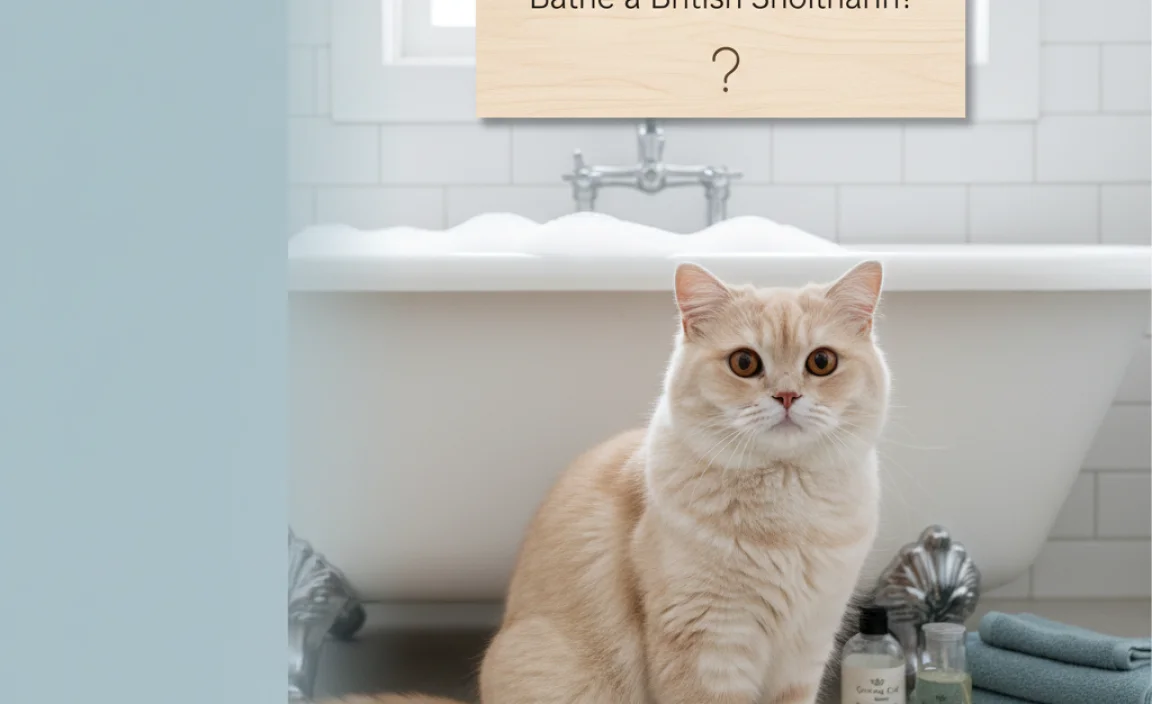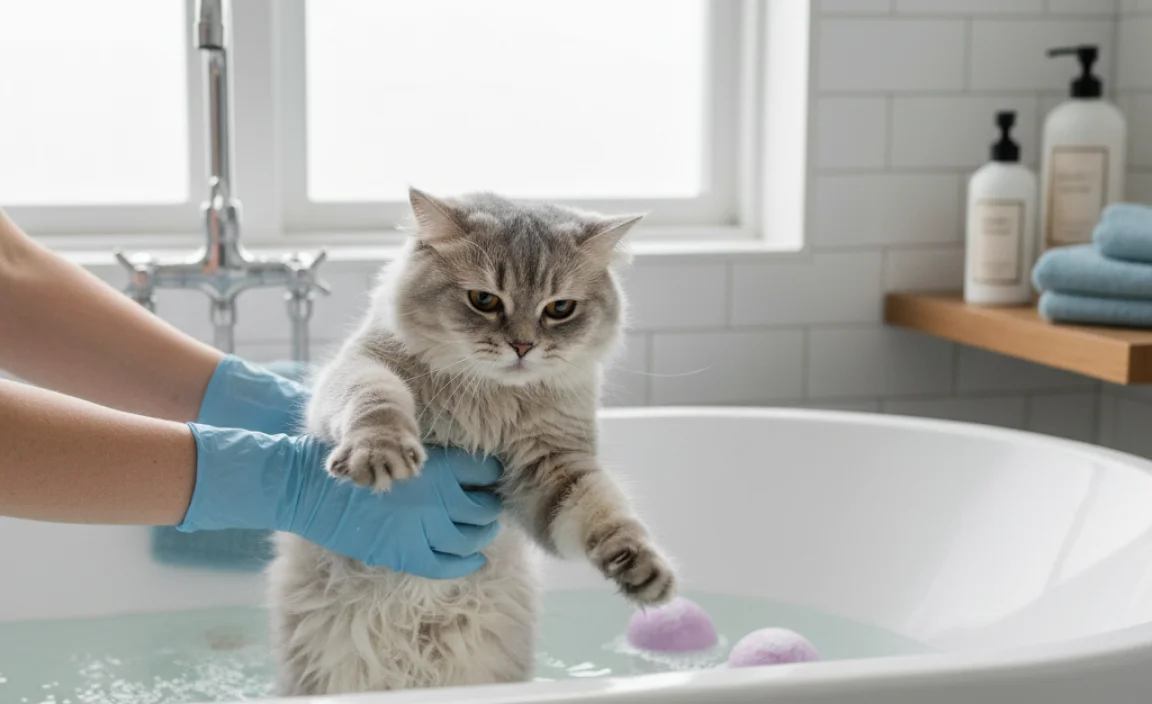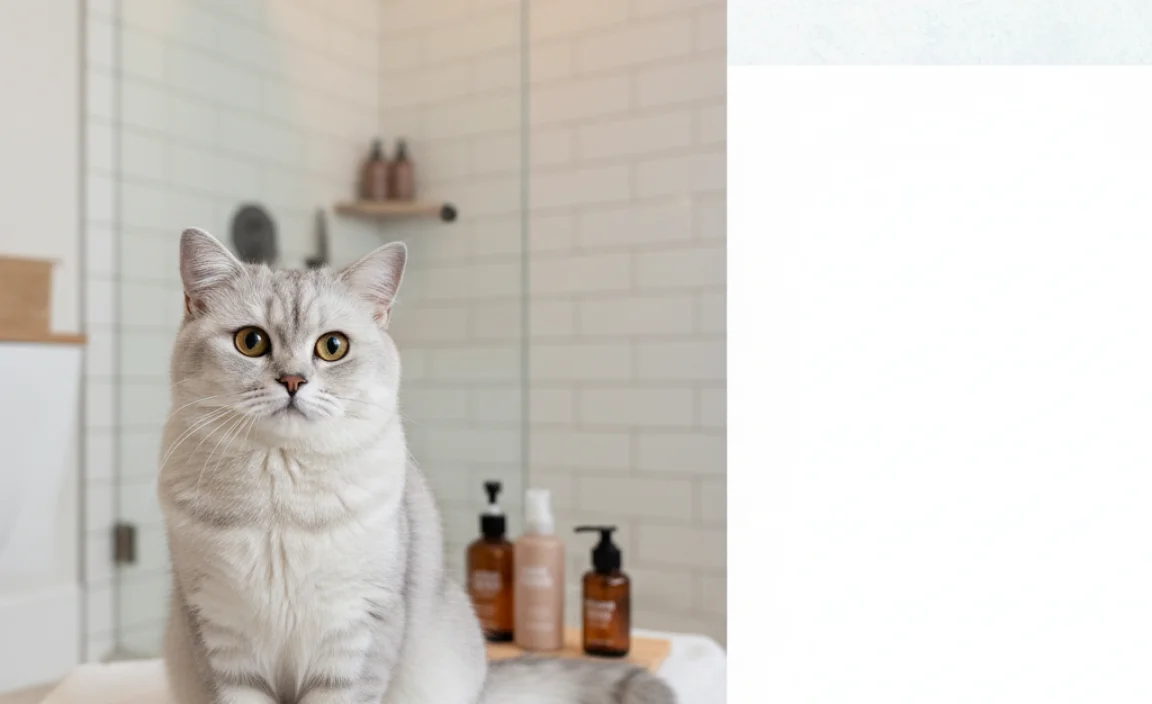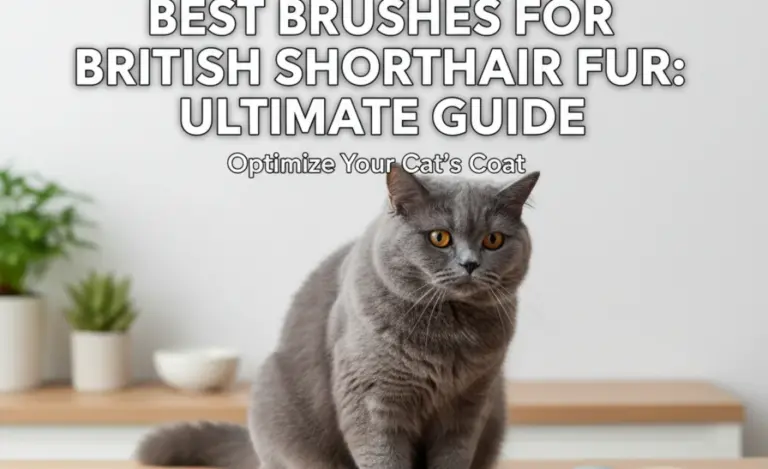Bath Frequency for British Shorthairs: The Ultimate Guide
Quick Summary: Generally, British Shorthairs don’t need frequent baths. Usually, bathing them every few months is enough, or even less if they stay clean on their own. Over-bathing can dry out their skin and coat. If your British Shorthair gets dirty or smelly, then it’s time for a bath. Always use a cat-friendly shampoo and make the experience as stress-free as possible!
Do you ever wonder how often your fluffy British Shorthair needs a bath? It’s a common question! Luckily, British Shorthairs are naturally clean cats. They spend a lot of time grooming themselves. So, you won’t need to bathe them very often. Over-bathing can actually do more harm than good! It can dry out their skin and make their coat dull. But when is the right time to reach for the shampoo? Let’s find out the best way to keep your British Shorthair clean and happy.
How Often Should You Bathe a British Shorthair?

British Shorthairs are known for their thick, plush coats. But those coats don’t need as much bathing as you might think! In most cases, you only need to bathe your British Shorthair a few times a year. Some cats might not even need that many baths. It really depends on their lifestyle and how well they groom themselves.
Factors That Affect Bath Frequency
Several things can change how often your British Shorthair needs a bath:
- Indoor vs. Outdoor: Indoor cats usually stay cleaner than outdoor cats. If your cat spends a lot of time outside, it might need more baths.
- Grooming Habits: Some cats are great at keeping themselves clean. Others might need a little extra help from you.
- Health Conditions: Certain skin problems can make your cat need more frequent baths with special shampoo recommended by your vet.
- Age: Older cats may have trouble grooming themselves and need more help from you.
General Bathing Guidelines
Here’s a simple guide to help you decide when to bathe your British Shorthair:
- Every Few Months: This is a good starting point for most indoor British Shorthairs.
- When Dirty: If your cat gets into something messy, like mud or paint, it’s time for a bath.
- When Smelly: If your cat starts to smell bad, a bath can help freshen them up.
- As Recommended by Your Vet: If your cat has skin issues, follow your vet’s advice on bathing frequency.
Step-by-Step Guide to Bathing Your British Shorthair

Bathing a cat can be a bit tricky, but with the right approach, it can be a stress-free experience for both of you. Here’s how to do it:
1. Gather Your Supplies
Before you start, make sure you have everything you need:
- Cat Shampoo: Always use a shampoo made for cats. Human shampoo can be too harsh.
- Towels: Have a few soft, absorbent towels ready.
- Pitcher or Cup: For rinsing your cat.
- Brush: To brush your cat before and after the bath.
- Non-Slip Mat: Place this in the sink or tub to help your cat feel secure.
- Treats: To reward your cat and make the experience positive.
2. Prepare the Bathing Area
Get everything ready before you bring your cat into the bathroom:
- Close the Door: This will prevent your cat from escaping.
- Fill the Sink or Tub: Use lukewarm water. Make sure it’s not too hot or too cold.
- Lay Down the Mat: This will give your cat a good grip.
3. Brush Your Cat
Brush your cat before the bath to remove loose fur and mats. This makes it easier to wash and dry them.
4. Wet Your Cat
Gently wet your cat with the pitcher or cup. Avoid getting water in their eyes, ears, and nose. Talk to your cat in a calm, soothing voice.
5. Apply Shampoo
Put a small amount of shampoo in your hands and gently massage it into your cat’s coat. Start from the neck and work your way down. Be careful around the face and ears.
6. Rinse Thoroughly
Rinse your cat very well with the pitcher or cup. Make sure to get all the shampoo out of their coat. Leftover shampoo can irritate their skin.
7. Dry Your Cat
Wrap your cat in a towel and gently pat them dry. You can use a second towel to dry them further. If your cat tolerates it, you can use a hair dryer on a low, cool setting. Keep the dryer moving and don’t hold it too close to their skin.
8. Brush Again
Once your cat is dry, brush their coat again to remove any remaining tangles and help it look its best.
9. Reward Your Cat
Give your cat a treat and lots of praise after the bath. This will help them associate bathing with positive experiences.
Choosing the Right Shampoo

Picking the right shampoo is super important for your British Shorthair’s skin and coat health. Here’s what to look for:
- Cat-Specific: Always use a shampoo made for cats. Human shampoos have different pH levels and can irritate your cat’s skin.
- Gentle Formula: Look for a shampoo that is gentle and doesn’t contain harsh chemicals.
- Hypoallergenic: If your cat has sensitive skin, choose a hypoallergenic shampoo.
- Moisturizing: A moisturizing shampoo can help keep your cat’s skin from drying out.
- Avoid Fragrances: Strong fragrances can irritate your cat’s skin and respiratory system.
Recommended Shampoos
Here are a few cat shampoos that are known for being gentle and effective:
- Oatmeal Shampoo: Great for soothing dry, itchy skin.
- Hypoallergenic Shampoo: Ideal for cats with allergies or sensitive skin.
- Flea Shampoo: If your cat has fleas, use a shampoo specifically designed to kill them. Always consult your vet first.
Dealing with Difficult Cats

Not all cats enjoy bath time. If your British Shorthair is resistant to bathing, here are some tips to make it easier:
- Start Young: Get your cat used to being handled and bathed from a young age. This will make it easier as they get older.
- Be Gentle: Always handle your cat gently and speak in a calm, soothing voice.
- Use Treats: Reward your cat with treats throughout the bathing process.
- Short Baths: Keep the baths short and sweet. Don’t try to do too much at once.
- Distraction: Try distracting your cat with a toy or treat while you’re bathing them.
- Enlist Help: If you’re having trouble, ask a friend or family member to help you.
- Professional Groomer: If all else fails, consider taking your cat to a professional groomer.
The Importance of Regular Grooming

Besides bathing, regular grooming is essential for keeping your British Shorthair’s coat healthy and beautiful. Here’s why:
- Removes Loose Fur: Regular brushing helps remove loose fur, which reduces shedding and prevents mats.
- Stimulates Skin: Brushing stimulates the skin and promotes healthy blood flow.
- Distributes Oils: Brushing helps distribute natural oils throughout the coat, keeping it shiny and healthy.
- Bonding: Grooming is a great way to bond with your cat and strengthen your relationship.
Grooming Tools
Here are some essential grooming tools for your British Shorthair:
- Slicker Brush: This brush is great for removing loose fur and preventing mats.
- Comb: A comb can help you find and remove tangles.
- Rubber Brush: This brush is gentle and good for cats with sensitive skin.
Grooming Schedule
Aim to groom your British Shorthair at least once a week. During shedding season (spring and fall), you may need to groom them more often.
Health Benefits of Proper Grooming
Proper grooming isn’t just about keeping your cat looking good. It also has several health benefits:
- Early Detection of Problems: Regular grooming allows you to check your cat for any lumps, bumps, or skin problems.
- Prevents Mats: Mats can be painful and can trap moisture, leading to skin infections.
- Reduces Hairballs: Regular brushing reduces the amount of hair your cat swallows, which can help prevent hairballs.
- Improves Circulation: Brushing stimulates blood flow and promotes healthy skin.
British Shorthair Coat Care Tips
Taking care of your British Shorthair’s coat involves more than just bathing and grooming. Here are some extra tips to keep their fur in tip-top shape:
- Diet: Feed your cat a high-quality diet rich in omega-3 and omega-6 fatty acids. These nutrients promote healthy skin and coat.
- Hydration: Make sure your cat always has access to fresh water. Dehydration can lead to dry, dull fur.
- Supplements: Consider adding a supplement to your cat’s diet to support skin and coat health. Consult your vet before starting any new supplements.
- Regular Vet Checkups: Regular vet checkups can help identify and address any underlying health issues that may be affecting your cat’s coat.
Common Coat Problems in British Shorthairs
Even with the best care, British Shorthairs can sometimes develop coat problems. Here are some common issues to watch out for:
- Excessive Shedding: All cats shed, but excessive shedding can be a sign of stress, allergies, or a poor diet.
- Dandruff: Dandruff can be caused by dry skin, allergies, or parasites.
- Mats: Mats are tangled clumps of fur that can be painful and difficult to remove.
- Hair Loss: Hair loss can be a sign of skin infections, allergies, or hormonal imbalances.
Table: Troubleshooting Common Coat Problems
| Problem | Possible Causes | Solutions |
|---|---|---|
| Excessive Shedding | Stress, allergies, poor diet | Reduce stress, identify allergens, improve diet, brush more frequently |
| Dandruff | Dry skin, allergies, parasites | Use moisturizing shampoo, identify allergens, treat parasites, increase humidity |
| Mats | Lack of grooming, long fur | Brush regularly, trim mats carefully, consider professional grooming |
| Hair Loss | Skin infections, allergies, hormonal imbalances | Consult vet, treat infections, identify allergens, address hormonal issues |
When to See a Vet
If you notice any of the following signs, it’s important to take your British Shorthair to the vet:
- Sudden hair loss
- Red, inflamed skin
- Excessive scratching or licking
- Open sores or lesions
- Changes in appetite or behavior
These symptoms could indicate an underlying health problem that needs to be addressed.
Debunking Bathing Myths
There are a lot of myths out there about bathing cats. Let’s clear up some common misconceptions:
- Myth: Cats don’t need baths.
Fact: While cats are good at grooming themselves, they still need occasional baths to remove dirt and oil. - Myth: You can use human shampoo on cats.
Fact: Human shampoo can be too harsh for cats and can irritate their skin. Always use a shampoo made for cats. - Myth: Bathing cats is always stressful.
Fact: With the right approach, bathing can be a positive experience for both you and your cat. - Myth: All cats hate water.
Fact: Some cats actually enjoy water! You might be surprised.
Conclusion
So, how often should you bathe your British Shorthair? Remember, less is often more! These cats are naturally clean and don’t need frequent baths. By paying attention to your cat’s lifestyle, grooming habits, and overall health, you can find the perfect bathing schedule. Regular grooming, a healthy diet, and the occasional bath will keep your British Shorthair’s coat looking beautiful and feeling great. Enjoy your time with your fluffy friend!
Frequently Asked Questions (FAQs)
1. Can I use baby shampoo on my British Shorthair?
No, it’s best not to use baby shampoo. Even though it’s mild, it’s still formulated for human skin. Cat-specific shampoos are pH-balanced for their skin and won’t cause irritation.
2. My cat hates water. How can I make bath time easier?
Start slowly! Get your cat used to being handled and around water gradually. Use treats, stay calm, and make the baths short. If it’s too stressful, try spot cleaning with a damp cloth instead.
3. What if my British Shorthair licks the shampoo during the bath?
Try to prevent your cat from licking the shampoo. Use a small amount and rinse very thoroughly. Cat-specific shampoos are generally non-toxic, but ingestion can still cause stomach upset. If your cat seems unwell after a bath, contact your vet.
4. How do I dry my British Shorthair without a hair dryer?
Towel-drying is perfectly fine! Use soft, absorbent towels and gently pat your cat dry. Keep them in a warm place until they’re completely dry to prevent them from getting chilled.
5. Can I use dry shampoo on my British Shorthair?
Yes, dry shampoo can be a good option for quick cleaning between baths. Make sure to use a dry shampoo specifically made for cats. Apply it gently and brush it through their coat.
6. How often should I brush my British Shorthair?
Aim to brush your British Shorthair at least once a week. During shedding season, you might want to brush them every day to help remove loose fur.
7. My cat has fleas. Can I use regular cat shampoo to get rid of them?
No, you’ll need to use a flea shampoo specifically designed to kill fleas. Follow the instructions on the label carefully, and talk to your vet about the best flea control options for your cat.




